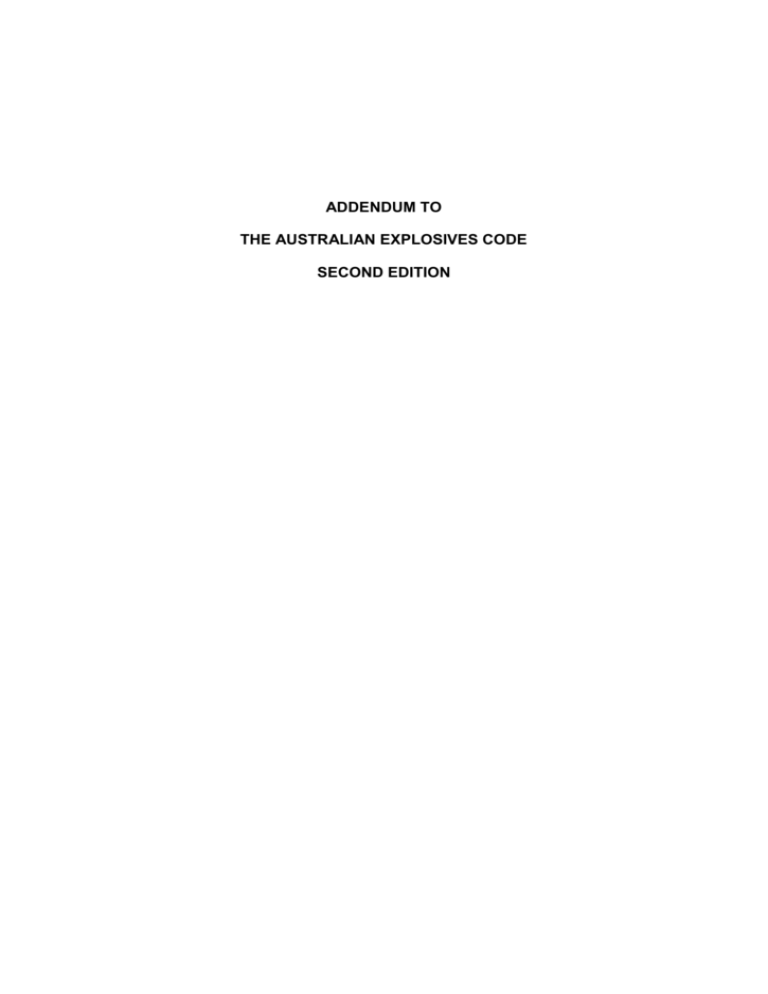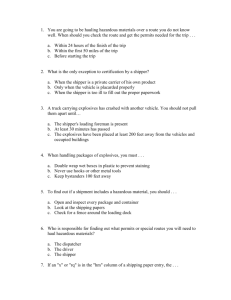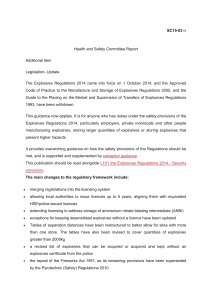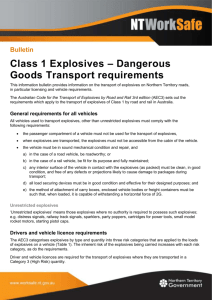
ADDENDUM TO
THE AUSTRALIAN EXPLOSIVES CODE
SECOND EDITION
© Commonwealth of Australia 2003
ISBN 0 975 19403 8
This work is copyright. You may download, display, print and reproduce this material in
unaltered form only (retaining this notice) for your personal, non-commercial use or use within
your organisation. All other rights are reserved. Requests and inquiries concerning
reproduction and rights should be addressed to the Commonwealth Copyright Administration,
Intellectual Property Branch, Department of Communications, Information Technology and the
Arts, GPO Box 2154, Canberra ACT 2601 or posted at http://www.dcita.gov.au/cca.
1.1
Scope and interpretation of the Code
Amend 1.1(2)(c) ‘which have been confiscated or received by, and under the direct
supervision of, the police or the Competent Authority in the cause of public safety’ to
read:
(2)(c) which have been confiscated or received by, and under the direct
supervision of, an emergency service or the Competent Authority in
the cause of public safety.
1.2
Definitions
Insert in appropriate alphabetical order in 1.2:
“Authorisation” means by way of a licence, permit or other means.
“High Security Risk Load” is that load consisting of that quantity of explosives in
any row of Table 2.2 based on the load per vehicle, where a road vehicle includes a
combination vehicle;
“Emergency service” means:
(a)
an ambulance, fire, police or other emergency service;
(b)
a unit of the Defence Force corresponding to a service mentioned in
paragraph (a);
1.3
List of codes, standards, rules and other instruments referred to
in this Code
Insert in appropriate numerical order in 1.3(2):
AS 4145
AS 4255
Locksets
Part 2 – Mechanical locksets for doors in buildings;
Part 4 – Padlocks
Security seals
Part 1 – Classification;
Part 2 – Use
Insert as a new entry:
TABLE 2.2
High Security Risk Loads of Explosives
Type of Explosive
Quantity
Division 1.1 other than detonators and fireworks
Exceeding 1000kg
Detonators of 1.1B, 1.4B and/or 1.4S
Exceeding 5000 items
Division 1.2 other than fireworks
Exceeding 5000kg
Classification Code 1.3C
Exceeding 1000kg
Division 1.5
Exceeding 1000kg
Ballistic discs / shaped charges (NEQ > 5kg),
hand grenades (high explosive), mines (including land
and anti-tank), and man portable self-contained high
explosive weapons systems.
One or more
Notes:
(1)
The quantities of explosives set out in the rows of Table 2.2 are not aggregated in
determining whether a load is a high security risk load of explosives.
(2)
The quantity specified in column 2 is based on load per vehicle, where a road vehicle
includes a combination vehicle.
Insert as a new entry:
6.1.1
Requirements for Locks
(1)
The owner of a vehicle used, or intended to be used, to transport high
security risk loads of explosives, and the prime contractor, shall
ensure that any receptacle, carry box, container or IBC used to
transport such explosives by road or rail shall be lockable.
(2)
If locks, such as padlocks or locksets, are used to provide locking
security for high security risk loads of explosives being conveyed on a
vehicle, the locks shall be of a type that is intended to prevent
unauthorised entry. Australian Standard AS 4145.4: Locksets –
Padlocks, and Australian Standard AS 4145.2: Locksets – Mechanical
locksets for doors in buildings, provide guidance to typical locks that
may provide such security.
Note: An example of a suitable padlock standard, according to Clause
A1.6 of Appendix A of AS 4145.4, is SP3, K1 to K4, D1 or D2, C2.
(3)
Where other types of locking mechanisms, such as security seals, are
used to provide security for high security risk loads of explosives being
conveyed on a vehicle, they shall provide the level of security outlined
in Clause 6.1.1(2). (Australian Standard AS 4255.1: Security seals –
Classification and Australian Standard AS 4255.2: Security seals –
Use, provide guidance about seals that may provide such security).
6.2
Requirements for Enclosed Vehicle Bodies and Carry Boxes
Amend 6.2(1) ‘Explosives (other than of Classification 1.4S), in Categories 1 and 2
quantities shall be transported in a locked receptacle securely fixed to the vehicle.
The inside surface of the receptacle shall be of wood or some other material
incapable of producing incendive sparks. Where the explosives are transported in
sealed packages and in an enclosed portion of the vehicle, not being the passenger
compartment (e.g. luggage compartment of a sedan), a receptacle is not required’ to
read:
(1)
When an enclosed vehicle body or carry box is used in the
transport of explosives (other than of Classification Code 1.4S
other than detonators), in Category 1 and 2 quantities, the
following requirements apply:
(a)
an enclosed vehicle body shall be lockable;
(b)
a carry box, when not contained within an enclosed
vehicle body, shall be lockable and securely attached to
the vehicle;
(c)
the inside surface of an enclosed vehicle body or carry
box shall be of wood or some other material incapable
of producing incendive sparks;
(d)
where the explosives are transported in the passenger
compartment of a vehicle, a lockable carry box is
required;
(e)
where the explosives are transported in sealed
packages and in any other enclosed portion of a road
vehicle (e.g. boot or luggage compartment of a sedan),
a carry box is not required.
Insert as a new entry:
(3)
When high security risk loads of explosives are transported in
an enclosed vehicle body direct access to the explosives from
the cabin of a vehicle shall not be possible.
Amend subclause number ‘6.2 (3)’ to read ‘6.2 (4)’
Amend subclause number ‘6.2 (4)’ to read ‘6.2 (5)’
Insert as a new entry:
8.2.13 Locking Requirements
The owner of a road vehicle, used, or intended to be used to transport
explosives, the prime contractor and the driver of the road vehicle shall
ensure that any receptacle, carry box, container, IBC and enclosed vehicle
body and other enclosed portion of a road vehicle containing explosives shall
be locked during the actual transport.
Insert as a new entry:
8.2.14 Audit Requirements
The prime contractor shall ensure that a recorded check or audit is carried out
at the final destination to determine that there is no discrepancy between the
quantities and types of explosives loaded and unloaded against the
documentation. Where a discrepancy is discovered during a check or audit,
the prime contractor shall immediately notify the local police station and the
relevant Competent Authority of Explosives.
8.4.3
Requirements for Drivers and Attendants
Amend 8.4.3(2) ‘A person shall not drive a vehicle used to transport explosives
unless the person is authorised to do so by a Competent Authority’ to read:
(2)
A person shall not drive a road vehicle used to transport explosives
unless the person is authorised to do so by a Competent Authority.
The Competent Authority shall not so authorise such a person if in the
10 years before the date of when the application for authorisation is
made, or in the instance of renewals, since the date of the previous
authorisation:
(a)
the applicant has been found guilty by a court in Australia or
elsewhere of an offence that, in the opinion of the Competent
Authority, makes the applicant unsuitable to be the driver of a
road vehicle transporting high security risk loads of explosives;
or
(b)
the applicant’s driving licence has been cancelled or
suspended on a ground that, in the opinion of the Competent
Authority, makes the applicant unsuitable to be the driver of a
vehicle transporting high security risk loads of explosives; or
(c)
the applicant’s criminal history determined from a national
name check with a disclosable category of full exclusion is
such that, in the opinion of the Competent Authority, makes the
applicant unsuitable to be the driver of a road vehicle
transporting high security risk loads of explosives.
Amend 8.4.3(3)(d) ‘the person has been examined by a qualified medical practitioner
and found not to have any medical or physical condition that would impair the
person’s ability to perform the duties of a driver of a road vehicle used to transport
explosives’ to read:
(3)
(d)
the person has been examined by a qualified medical
practitioner, to the requirements specified in the Medical
Examinations of Commercial Vehicle Drivers published by the
National Road Transport Commission, and found not to have
any medical or physical condition that would impair the
person’s ability to perform the duties of a driver of a road
vehicle used to transport explosives.
Insert as a new entry:
8.8
Requirements for High Security Risk Loads of Explosives
8.8.1
Application of Sub-section
8.8 sets out requirements which apply to the transport of explosives in a
quantity sufficient to qualify as a high security risk load. These requirements
are additional to those elsewhere specified in this Code, in particular 8.2, 8.3
and 8.4. For the purposes of this Code, a high security risk load of explosives
is defined in 1.2.
8.8.2
Security Plans
(1)
The prime contractor shall develop and maintain a written security
plan that shall cover the arrangements and procedures for the
transport of high security risk loads of explosives by road or rail and
include at least the following:
(2)
(a)
a description of the measures for preventing the theft of the
explosives being transported by road or rail and for preventing
unauthorised people from having access to those explosives;
(b)
a statement setting out the vehicle design requirements for
vehicles used to transport the explosives, and the load
securing requirements for securing and protecting those
explosives;
(c)
a description of the arrangements for emergency
communications in the event of an emergency involving those
explosives;
(d)
a statement setting out the requirements for training for
persons involved in the transport of the explosives by road or
rail (training would include dealing with security emergencies
and transporting explosives safely); and
(e)
a statement setting out the requirements for ensuring that
vehicles transporting the explosives travel by the safest
practicable route, including the procedures for planning
transport routes. In this context, safe includes the most
appropriate route, considering the risk.
The prime contractor of a security plan shall provide upon request the
security plan for inspection by the relevant Competent Authority.
8.8.3
Compliance with Security Plans
(1)
A person who transports high security risk loads of explosives shall
comply with any requirement of a security plan that is applicable to the
person.
(2)
However, if there is an inconsistency between a requirement of a
security plan, as it applies to the person, and a requirement of this
Code as it applies to the person, the requirement of this Code prevails
to the extent of the inconsistency.
8.8.4
Monitoring Systems Requirements
The owner of a road vehicle used, or intended to be used, to transport high
security risk loads of explosives, and the prime contractor, shall ensure that a
system is in place that will ensure that:
(a)
the location of high security risk loads of explosives is known and
recorded, independent of the driver, in compliance with the security
plan; and
(b)
in the event of breach of security involving high security risk loads of
explosives, immediate notification is made of the location and time of
the event to enable response assistance.
8.8.5
Duties of Drivers, Prime Contractors, Vehicle Owners and Others
(1)
A person shall not drive a road vehicle conveying high security risk
loads of explosives unless the person satisfies the requirements as set
out in 8.4.3(2) and 8.4.3(3).
(2)
The owner of a road vehicle used for transporting high security risk
loads of explosives, and the prime contractor, shall take all practicable
steps to ensure that every person who drives the vehicle while those
high security risk loads of explosives are aboard is authorised to do so
by the Competent Authority.
(3)
The prime contractor and the person who offers or consigns high
security risk loads of explosives for transport by road vehicle shall
comply with the requirements of 8.4.5 as if the high security risk loads
of explosives were explosives in Category 3.
8.8.6
Requirements for Persons Loading, Unloading and Transferring
Explosives and Persons Working or Riding on a Vehicle
(1)
A person who is involved in the loading onto, unloading from or the
transfer to or from a vehicle of packages or IBCs where the total load
is a high security risk load of explosives shall have undergone a
national name check that, in the opinion of the Competent Authority,
indicates that the applicant is suitable to be involved with high security
risk loads of explosives.
(2)
A person shall not work or ride on a road vehicle conveying high
security risk loads of explosives unless that person has undergone a
national name check that, in the opinion of the Competent Authority,
indicates that the person is suitable to work or ride on a road vehicle
conveying high security risk loads of explosives.
(3)
Where the monitoring requirements of 8.8.4 are met by the provision
of an escort vehicle, then the requirements of 8.8.6(2) apply to the
driver, and any passengers, in that escort vehicle.
(4)
A person who is under the direct and constant supervision of a person
meeting the requirements of 8.8.6(1) is exempted from meeting the
requirements of 8.8.6(1).
8.8.7
Competencies for Drivers
A person shall not drive a road vehicle conveying high security risk loads of
explosives unless that person has successfully completed approved
competency based training relating to the transport of explosives.
8.8.8
Emergency Procedure Guides
The provisions relating to Emergency Procedure Guides in 8.3.7 and 8.3.8
apply to high security risk loads of explosives as if such loads were a
Category 2 and 3 load of explosives.
FIGURE 8.1 and FIGURE 8.2
Insert the following matter in Figure 8.1 and Figure 8.2, on the front of the
Emergency Procedure Guide, above the box labelled ‘First Aid’:
MISSING OR STOLEN EXPLOSIVES
In the event of explosives being found to be stolen or missing (Refer 8.2.14),
the driver shall ensure that the police (dial “000”) and the Competent
Authorities are notified as soon as possible.







